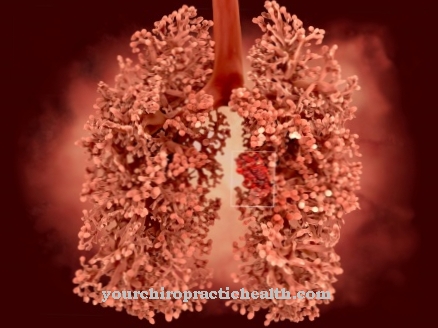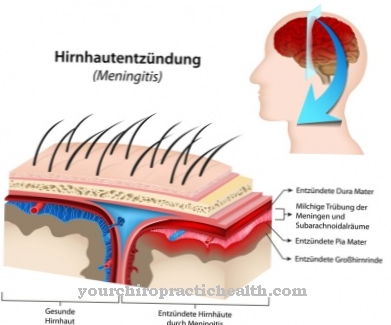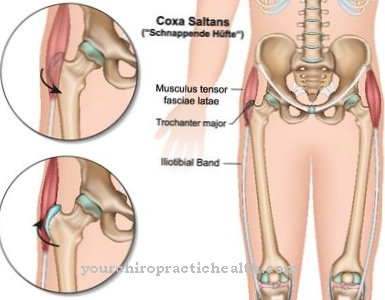The multiple endocrine neoplasia (MEN) is the collective term for various - based on genetic defects - cancers of the endocrine glands, i.e. hormone-producing glands such as the pancreas, parathyroid and pituitary gland. Sustainable therapy is usually only possible by completely removing the corresponding gland.
What is multiple endocrine neoplasia?

Multiple endocrine neoplasms can be divided into type 1 (MEN 1, Wermer syndrome), type 2A (MEN 2A, Sipple syndrome) and type 2B (MEN 2B, William syndrome and Gorlin syndrome) depending on the physiological characteristics and other specifics become.
MEN 1 mainly affect the parathyroid, pancreas and pituitary gland. Typically, the neoplasms in the affected endocrine glands do not respond to regulating control hormones, so that, as a rule, excessive hormone production occurs in the glands. The thyroid, parathyroid, and adrenal medulla can develop MEN 2A and 2B neoplasms.
In type 2B, neoplasms can also develop in other organs at the same time. Strictly speaking, there are also the other subgroups of types 3A, 3B and 3C, which mainly affect the parathyroid glands, the sympathetic nervous system and the digestive tract.
causes
Multiple endocrine neoplasms of type 1 are "approved" - not caused, for example - by a mutated tumor suppressor gene on chromosome 11. The gene that normally gives the command to combat such growths loses its effectiveness as a result of the mutation, so that endocrine-disrupting tumors and other neoplasms can form on the affected endocrine glands without being suppressed by the body's own means.
Type 2 MEN are caused by a mutation in another gene that causes proto-oncogenes to lose their function. When cells divide in the affected organs, the growth process can no longer be controlled, so that the development of neoplasms is not controlled and slowed down with the body's own means.
Both gene mutations can be detected in a gene analysis and both gene mutations are inherited in an autosomal dominant manner, which means that the parent who is affected by one of the genetic defects will pass the genetic defect on to all children and they have a 50 percent risk of developing the disease .
Symptoms, ailments & signs
The symptoms of multiple endocrine neoplasia depend on the form of the disease. In MEN type 1 (Wermer syndrome), the parathyroid glands, the pancreas and the pituitary gland are particularly affected. The parathyroid glands develop hyperplasia, which is associated with a so-called hyperparathyroidism.
Patients have too much parathyroid hormone in their blood. This mainly leads to bone loss. Pancreatic neoplasms with excessive production and release of hormones have a negative impact on the metabolism in particular. One consequence of this neoplasm is Zollinger-Ellison syndrome, which is characterized by ulcers in the stomach and small intestine.
In multiple endocrine neoplasia, prolactinomas in particular occur in the pituitary gland. These are tumors that produce the hormone prolactin. As a result, women do not ovulate or menstruate. Some patients also develop galactorrhea, which means that they produce breast milk in the mammary glands outside of pregnancy and while breastfeeding.
In the case of men, however, erectile dysfunction and loss of libido are the main focus. Galactorrhea rarely occurs here. The thyroid and adrenal medulla can also be affected by multiple endocrine neoplasia. Nervousness, increased blood pressure or diarrhea are among the symptoms.
Diagnosis & course
In principle, a readiness for the outbreak of multiple neoplasms of type 1 and 2 can be determined in a genetic analysis, which is particularly useful if there are already cases of MEN in the family and ethical reasons do not conflict with a genetic analysis.
Early indicators of the presence of MEN 1 are increased levels of certain hormones that are produced by the endocrine glands. The increased values can be an indicator of already developed endocrine-disrupting neoplasms that do not respond to control hormones.
If tumors have already developed in at least 2 of the 3 affected organs at the same time, the suspicion of MEN 1 is confirmed. The disease progression in MEN 1 and 2 is very difficult without treatment. In most cases, endocrine-disrupting neoplasms lead to significant overconcentrations of the specific hormones in the affected glands and, on the other hand, malignant carcinomas are life-threatening.
Complications
As a result of this disease, those affected usually suffer from various cancers. The further course of the disease depends very much on the particular disease, so that a general prediction of the course of the disease is usually not possible.In most cases, those affected suffer from pain in the abdomen and stomach and, associated with this, often from a lack of appetite.
This also leads to malnutrition and usually also to weight loss. Patients may vomit, feel sick, and have pain in the muscles. As a rule, this disease leads to a significantly reduced quality of life and various restrictions in the everyday life of the person affected.
As a rule, the patient dies prematurely without treatment. Self-healing does not occur in this case. For treatment, patients are dependent on surgical interventions to remove the tumors. There are no further complications. However, the further course depends heavily on the severity of the tumor. The patient's life expectancy may also be reduced by the disease.
When should you go to the doctor?
If characteristic symptoms such as hormonal imbalances or an impaired bone structure are noticed, a doctor should be consulted. Multiple endocrine neoplasia is a serious disease that needs to be diagnosed and treated as early as possible. Otherwise, serious physical problems can develop, which permanently impair the quality of life and well-being of the patient. Therefore, medical advice should be sought at the first signs of illness.
If you notice disorders of the nervous system, organ pain or psychological complaints such as depression and moods, it is best to inform your family doctor. This can diagnose any tumors and initiate further treatment measures. In addition to the general practitioner, an internist or neurologist can also be consulted if multiple endocrine neoplasia is suspected. Depending on the location of the tumors, gastroenterologists and nephrologists should also be consulted. The actual treatment takes place as an inpatient in a specialist clinic for internal diseases. Close monitoring by a specialist is necessary during treatment, as the symptoms, which are usually advanced, pose a risk of serious complications.
Treatment & Therapy
Treatment of multiple endocrine neoplasia is highly dependent on the organ affected and the stage of the cancer. If z. If, for example, mutated genes are detected in a child in the genetic analysis, which predict the disease in MEN 2 with the highest probability, a prompt surgical removal of the thyroid gland (thyroidectomy) is urgently recommended, including the removal of all lymph nodes in the neck area in order to avoid potential problems from the outset Remove metastases in the lymphatic area near the thyroid gland.
Depending on the severity of the analyzed gene mutations, this total operation should be carried out in children between the ages of 6 and 12. In some cases the so-called pentagastrin test can be carried out at regular time intervals, which indicates the development of an endocrine-disrupting carcinoma of the thyroid or parathyroid gland. Should z. If, for example, all 4 parathyroid glands are affected, almost all of the tissue except for a small remnant must be removed in order to maintain the natural production of the hormone of the parathyroid gland (parathyroid hormone), which plays a very important role in the calcium balance.
In specialized clinics, part of the parathyroid tissue removed is frozen so that it can be re-implanted in the patient if necessary, if the parathyroid tissue left in the body does not "start up" and does not produce parathyroid hormone.
Outlook & forecast
The prognosis for multiple endocrine neoplasia is poor. Patients who receive such a diagnosis suffer from a genetic defect. Current legislation prohibits researchers and scientists from modifying human genetics. Therefore, the measures of a treatment are limited to the alleviation of the existing and individually pronounced complaints.
Although there are many therapeutic approaches that alleviate numerous symptoms, there is no prospect of recovery given the current status. Long-term therapy and regular check-ups are necessary so that an optimal response can be made as quickly as possible in the event of irregularities. Without adequate and comprehensive medical care, the risk of shortening the expected lifespan is significantly increased.
The patients suffer from various cancers that contribute to a significant deterioration in the general quality of life. The design possibilities of everyday life are reduced, so that the focus of the initiated treatment provides not only an improvement of the physical possibilities but also an optimization of the well-being. In many patients, the affected glands are removed. This will make the cancer less likely to recur. At the same time, however, this approach has numerous side effects and consequences for the patient. Dealing with the disease is therefore a particular challenge for those affected.
prevention
There is no direct prevention against the occurrence of the various forms of MEN. If a genetic analysis confirms the suspicion of one of the MEN forms based on familial genesis, ongoing screenings are recommended from the age of 10.
In laboratory tests, certain hormone levels are checked to determine whether endocrine-disrupting neoplasms have already formed. In addition, the use of diagnostic imaging methods such as ultrasound, CT, MRT and fMRI is necessary according to the specialist's specifications. Even the prophylactic removal of a threatened endocrine organ can be life-saving.
Aftercare
Patients with multiple endocrine neoplasia suffer more often than other people from carcinomas of organs that are related to the hormonal balance of the organism. Those affected not only develop tumors more often, but also develop cancer on average at a younger age. Follow-up care for people with multiple endocrine neoplasia therefore primarily relates to the postoperative condition.
If possible, diagnosed carcinomas should be removed surgically or treated with other types of therapy. After the surgery, the patient must remain under medical observation for a specified period of time. This reduces the likelihood of postoperative complications and enables rapid intervention.
However, some forms of cancer associated with multiple endocrine neoplasia have the tendency to recur. The focus of follow-up care is therefore on check-ups, which regularly check the patient's state of health and examine whether there is a recurrence or the emergence of new types of cancer. In this way, rapid medical intervention is possible if the affected person falls ill again.
In general, patients with multiple endocrine neoplasia support their state of health by leading a healthy lifestyle as possible, especially with regard to their predisposition to certain carcinomas. However, since it is a genetic disease, the risk of cancer can only be influenced slightly.
You can do that yourself
The symptoms of multiple endocrine neoplasia can be countered in everyday life with targeted measures. Typically, multiple organs are affected by the disease. It is therefore important to identify any genetic defects and also to examine family members. The sick people should definitely have the screening examinations carried out.
To avoid problems with an increased acid level, it makes sense to change your diet. In addition, the MEN disease affects the blood sugar level and leads to strong fluctuations here. Those affected must therefore keep a close eye on any changes in the gastrointestinal tract. This will help reduce problems like constipation and diarrhea. Changes in the skin can also occur. Increased awareness is required here in order to be active in good time if necessary.
Doctors often recommend surgically removing the thyroid gland as a preventive measure, depending on the severity of the multiple endocrine neoplasia. Here it is important to follow the doctor's recommendations and to find out about the following drug therapy. After the thyroid gland has been removed, the intake of thyroid hormones cannot be avoided. So it requires a lot of attention and a heightened awareness to use the medication properly and to observe your body.




.jpg)







.jpg)



.jpg)










.jpg)
